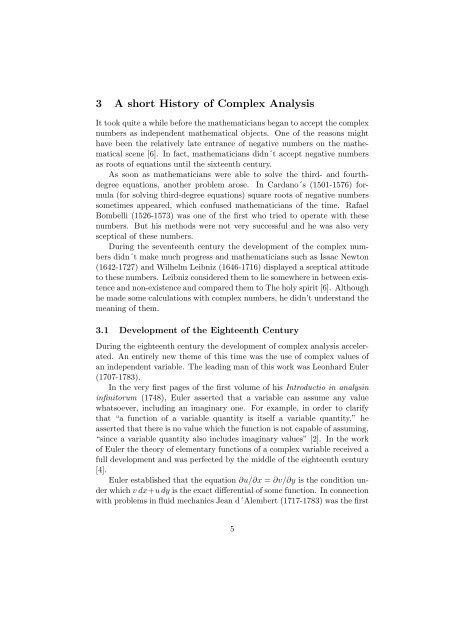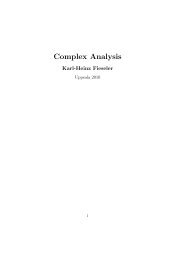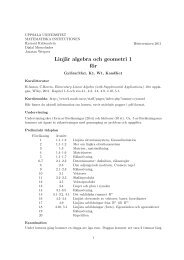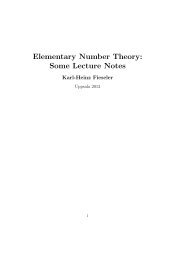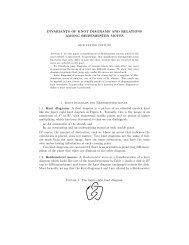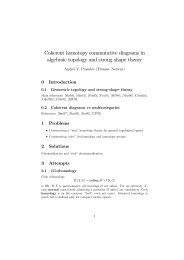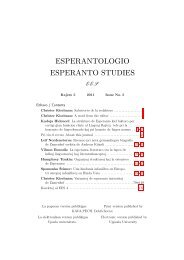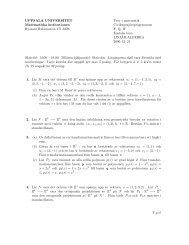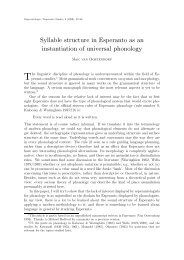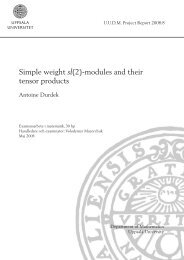Malmsten's Proof of the Integral Theorem
Malmsten's Proof of the Integral Theorem
Malmsten's Proof of the Integral Theorem
- No tags were found...
You also want an ePaper? Increase the reach of your titles
YUMPU automatically turns print PDFs into web optimized ePapers that Google loves.
3 A short History <strong>of</strong> Complex AnalysisIt took quite a while before <strong>the</strong> ma<strong>the</strong>maticians began to accept <strong>the</strong> complexnumbers as independent ma<strong>the</strong>matical objects. One <strong>of</strong> <strong>the</strong> reasons mighthave been <strong>the</strong> relatively late entrance <strong>of</strong> negative numbers on <strong>the</strong> ma<strong>the</strong>maticalscene [6]. In fact, ma<strong>the</strong>maticians didn´t accept negative numbersas roots <strong>of</strong> equations until <strong>the</strong> sixteenth century.As soon as ma<strong>the</strong>maticians were able to solve <strong>the</strong> third- and fourthdegreeequations, ano<strong>the</strong>r problem arose. In Cardano´s (1501-1576) formula(for solving third-degree equations) square roots <strong>of</strong> negative numberssometimes appeared, which confused ma<strong>the</strong>maticians <strong>of</strong> <strong>the</strong> time. RafaelBombelli (1526-1573) was one <strong>of</strong> <strong>the</strong> first who tried to operate with <strong>the</strong>senumbers. But his methods were not very successful and he was also verysceptical <strong>of</strong> <strong>the</strong>se numbers.During <strong>the</strong> seventeenth century <strong>the</strong> development <strong>of</strong> <strong>the</strong> complex numbersdidn´t make much progress and ma<strong>the</strong>maticians such as Isaac Newton(1642-1727) and Wilhelm Leibniz (1646-1716) displayed a sceptical attitudeto <strong>the</strong>se numbers. Leibniz considered <strong>the</strong>m to lie somewhere in between existenceand non-existence and compared <strong>the</strong>m to The holy spirit [6]. Althoughhe made some calculations with complex numbers, he didn’t understand <strong>the</strong>meaning <strong>of</strong> <strong>the</strong>m.3.1 Development <strong>of</strong> <strong>the</strong> Eighteenth CenturyDuring <strong>the</strong> eighteenth century <strong>the</strong> development <strong>of</strong> complex analysis accelerated.An entirely new <strong>the</strong>me <strong>of</strong> this time was <strong>the</strong> use <strong>of</strong> complex values <strong>of</strong>an independent variable. The leading man <strong>of</strong> this work was Leonhard Euler(1707-1783).In <strong>the</strong> very first pages <strong>of</strong> <strong>the</strong> first volume <strong>of</strong> his Introductio in analysininfinitorum (1748), Euler asserted that a variable can assume any valuewhatsoever, including an imaginary one. For example, in order to clarifythat “a function <strong>of</strong> a variable quantity is itself a variable quantity,” heasserted that <strong>the</strong>re is no value which <strong>the</strong> function is not capable <strong>of</strong> assuming,“since a variable quantity also includes imaginary values” [2]. In <strong>the</strong> work<strong>of</strong> Euler <strong>the</strong> <strong>the</strong>ory <strong>of</strong> elementary functions <strong>of</strong> a complex variable received afull development and was perfected by <strong>the</strong> middle <strong>of</strong> <strong>the</strong> eighteenth century[4].Euler established that <strong>the</strong> equation ∂u/∂x = ∂v/∂y is <strong>the</strong> condition underwhich v dx+u dy is <strong>the</strong> exact differential <strong>of</strong> some function. In connectionwith problems in fluid mechanics Jean d´Alembert (1717-1783) was <strong>the</strong> first5


